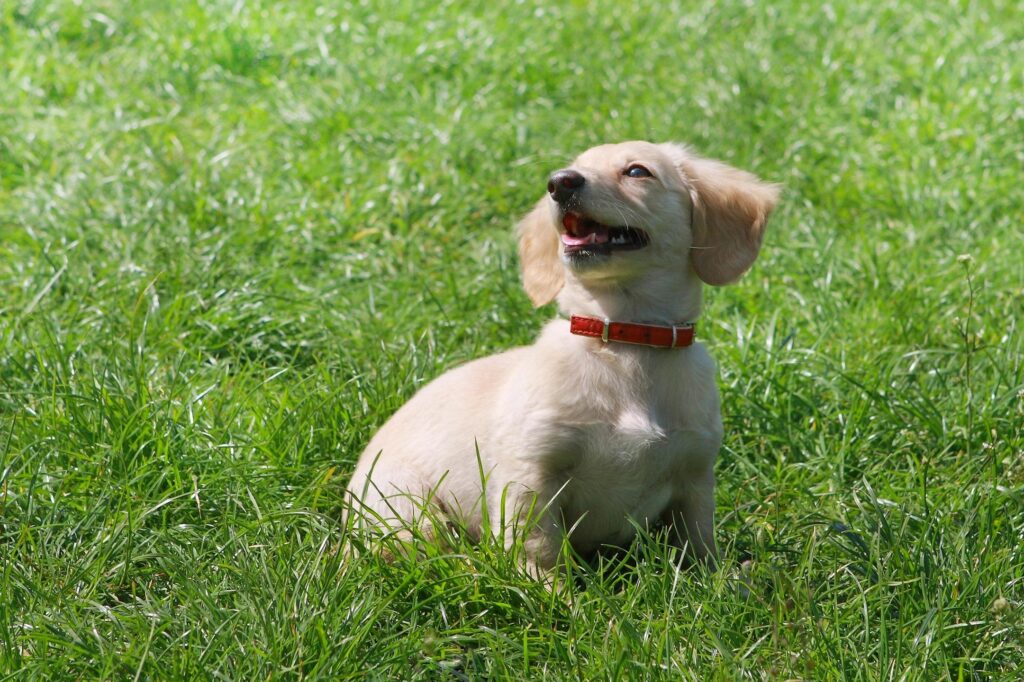Whether you call it potty training, housebreaking, or house training, one thing is for sure: it’s fairly simple, but that doesn’t mean it’s easy! Here’s how to potty train a puppy (or adult dog).

How to Potty Train a Puppy: Step 1- Be Consistent
With Mealtimes
First, establish consistent meal times, and do your best to stick to them. The benefit of consistent meal times is that it allows you to later observe your pup’s…shall we say…”turnaround time,” in other words, how long it takes after eating for your pup to need to go to the bathroom.
With Potty Breaks
Also, give your pup regular and frequent outdoor potty breaks at first. Start with 10-30 minutes after eating or drinking, and right after waking up or coming out of the crate, PLUS once an hour during awake hours. A young pup might need to go out once during the night, too. It’s a lot, but don’t worry, this is only temporary. The generaly rule of thumb is that a puppy can hold their bladder for their age in months, plus one. So a three month old puppy is generally able to hold their bladder for about four hours.
When you do go out for bathroom breaks, keep your dog on a leash so that you know whether he actually eliminated. Try not to let your pup get distracted by anything fun- toys, sticks, squirrels etc. If your pup does their business, give lots of praise, and resist the urge to go back inside immediately afterwards. You don’t want your dog to associate going to the bathroom with having to go back inside (assuming your dog likes being outside). If your pup doesn’t pee or poop, go back inside and be especially observant until the next scheduled potty break. You’ll eventually be able to reduce the number of potty breaks, but that will require some observation first. More on that in the next step.
With Logging
Finally, be consistent about keeping a log of when your pup peed and pooped. It’s also helpful to keep previous day’s logs for reference. That way, you’ll be able to look back and see, for example, that your pup peed between 11:15 and 11:45 most days, so that you can anticipate the likelihood that he’ll need to go out then. It’s also really helpful to be able to see problematic times of day. Let’s say your pup had several accidents in the past week. You can look through your log and might notice a trend. Perhaps the accidents tend to occur between 5-7pm, maybe because kids are now home from school and everyone wants to spend time with the new pup, but no one person is responsible for observing him.
We should point out, too, that establishing these routines is almost as much for the owner’s benefit as for the dog’s. With all the things we have to do in a day, it can be hard to be 100% attentive to your pup’s potty needs. Having a consistent schedule will help you anticipate when your dog will need to go out, and plan accordingly.
How to Potty Train a Puppy: Step 2- Be Observant
Between potty breaks, it’s absolutely essential that you are observant. You’ll need to be watching for any signs that your pup needs to go out: sniffing the floor, wandering off, whining, going to the door, or of course, squatting. This really comes down to limiting your pup to an area in which you’ll be able to watch him (or crate if you’re unable to watch him). Letting your pup have free run of the house is an accident waiting to happen. Here are the best ways to limit your dog to an area you can observe, from easiest to most challenging (in our opinion).
Use a Crate
If your dog is crate trained, this is one of the best ways to minimize the chance that he’ll potty in the house between outdoor breaks. Dogs are quite unlikely to use their crate as a toilet, assuming the crate is the correct size for them. A crate that is too large will allow them room to sleep in one part and poop in another. If you’re out of the house, a crate is a safe and comfortable place for your dog to nap (and they do sleep quite a lot of the day). Just be sure you don’t expect them to stay in the crate longer than they can be expected to hold their bladder, based on age. And of course, take them out before putting them in the crate, and as soon as they come out.
You can also use the crate for just those “high risk” times. Let’s say you observe that your dog is regularly peeing every 3 hours. It’s now been 2.5 hours, but you can’t give your pup your undivided attention for the next hour. This is a good time to put your pup in his crate, and then take him outside as soon as you let him out.
Use a Confined Area
Another option is to use a confined area. If your pup isn’t crate trained, or if you want to give him a little more freedom and you know you’ll be able to watch him sufficiently, you can limit him to a single room that you’ll be in, keeping one eye on him for any indicators that he might need to go out. A room or area close to the door will work best. Keep the leash handy!
Use a Leash
And finally, it is entirely possible to keep a constant eye on your dog by keeping him leashed to you. You can do this, and keep your hands free, by looping the leash around your waist. This tends to be a little difficult to do and sometimes a bit of a trip hazard, so it’s not our favorite, but it can be done!
How to Potty Train a Puppy: Step 3- Be Patient
Know that accidents will probably happen. When they do, the first thing you should do is to note it on your log, and look back at past days to see if you could have anticipated the need to go at that time. More often than not, accidents are the result of human error, not the dog’s error. If you find an accident that already happened, simply clean it up and try to learn from it. An enzymatic cleaner like this one works best. If you find an accident in progress, use a clap or sharp vocal correction to disrupt them. Then try to quickly get your dog outside, in the hopes of finishing his business outside. If he does, give him lots of praise, as you would normally do. And, we hope this goes without saying, but don’t rub your dog’s nose in it.
So that’s it! Simple, but not easy. Just stick to the plan, take one day at a time, and keep in mind that this is only temporary. If you’re considering a dog trainer for potty training or any other issue, give us a call! We’ll be happy to talk with you.
